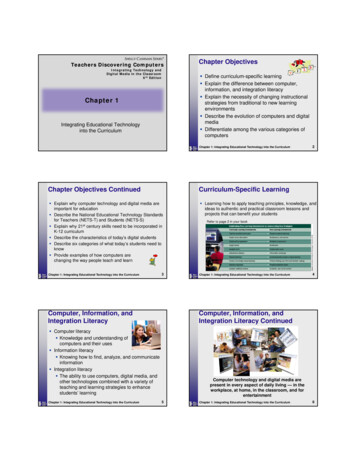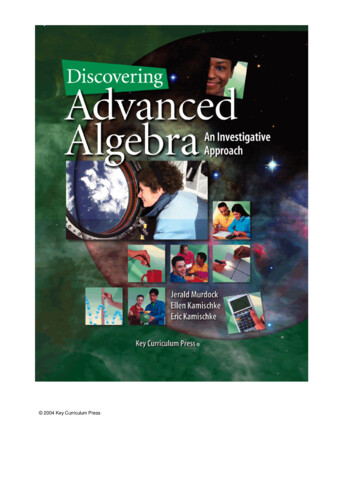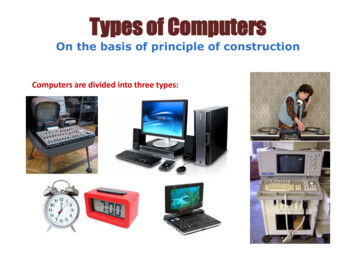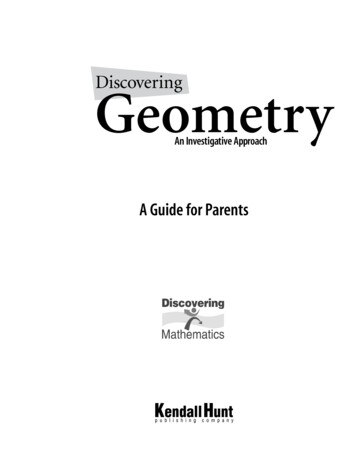
Transcription
Teachers Discovering ComputersIntegrating Technology andDigital Media in the Classroom6th EditionChapter Objectives Define curriculum-specific learning Explain the difference between computer,information, and integration literacy Explain the necessity of changing instructionalstrategies from traditional to new learningenvironments Describe the evolution of computers and digitalmedia Differentiate among the various categories ofcomputersChapter 1Integrating Educational Technologyinto the CurriculumChapter 1: Integrating Educational Technology into the Curriculum2Chapter Objectives ContinuedCurriculum-Specific Learning Explain why computer technology and digital media areimportant for education Describe the National Educational Technology Standardsfor Teachers (NETS-T) and Students (NETS-S) Explain why 21st century skills need to be incorporated inK-12 curriculum Describe the characteristics of today’s digital students Describe six categories of what today’s students need toknow Provide examples of how computers arechanging the way people teach and learn Learning how to apply teaching principles, knowledge, andideas to authentic and practical classroom lessons andprojects that can benefit your studentsChapter 1: Integrating Educational Technology into the Curriculum3Computer, Information, andIntegration LiteracyChapter 1: Integrating Educational Technology into the Curriculum4Computer, Information, andIntegration Literacy Continued Computer literacy Knowledge and understanding ofcomputers and their uses Information literacy Knowing how to find, analyze, and communicateinformation Integration literacy The ability to use computers, digital media, andother technologies combined with a variety ofteaching and learning strategies to enhancestudents’ learningChapter 1: Integrating Educational Technology into the CurriculumRefer to page 2 in your bookComputer technology and digital media arepresent in every aspect of daily living — in theworkplace, at home, in the classroom, and forentertainment5Chapter 1: Integrating Educational Technology into the Curriculum6
What Is a Computerand What Does It Do?What Is a Computerand What Does It Do? An electronic device, operating under the controlof instructions stored in its memory, that can Data - collection of unorganized facts Information - data that is organized, meaningful, anduseful Input - data entered into a computer Output - processed results from a computer accept inputted dataprocess the data according to specified rules,produce results as output, andstore the results for future useContinued Part 2 A computer is a computationaldeviceChapter 1: Integrating Educational Technology into the Curriculum7What Is a Computerand What Does It Do? Concluded Part 3The Evolution of Computersand Digital Media Storage – holding data andinformation for future use The goal of multimedia computingand communications is to assistindividuals in organizing andmanaging vast amounts ofinformation in various types of media Information processing cycle – the cycle ofinput, process, output, and storage Hardware – the electronic and mechanicalequipment that makes up the computer8Chapter 1: Integrating Educational Technology into the Curriculum Digital media – technologies that allow users tocreate new forms of interaction, expression,communication, and entertainment in a digitalformat Software – a series of instructions thattells the hardware how to perform tasks--Refer to graphic on next slideChapter 1: Integrating Educational Technology into the Curriculum9The Evolution of Computersand Digital Media ContinuedChapter 1: Integrating Educational Technology into the Curriculum10Categories of Computers Personal computers Mobile computers and mobile devices Game consoles (like the wii) Servers, supercomputers, andembedded computers--Details on each on next several slidesChapter 1: Integrating Educational Technology into the Curriculum11Chapter 1: Integrating Educational Technology into the Curriculum12
Mobile Computers andMobile DevicesPersonal Computers Mobile Computers Notebookcomputer Tablet PC Netbook Mobile Devices HandheldComputer PDA Smartphones A computer thatperforms all of itsinput, processing,output, and storageactivities by itselfChapter 1: Integrating Educational Technology into the Curriculum13 Server Mobile computing devicedesigned for single playeror multiplayer videogames Controller is the inputdevice Television is the outputdevice Hard Disks, CDs, DVDs,and memory cards areused for storage Manages the resources on a networkand provides a centralized storage areafor software programs and data Supercomputer Used for tasks such as analyzing weather patterns,tracking hurricanes, and identifying safety issuesregarding the space shuttle Embedded computer A special-purpose computer thatfunctions as one component in alarger product (ex: in a car engine or a furnace)15Why Use ComputerTechnology in Education?Chapter 1: Integrating Educational Technology into the Curriculum16Why Use ComputerTechnology in Education ? . .Continued International Society forTechnology in Education has setStandards for: Technology and digital media are everywhere! Technology can support learning Computers support communications beyondclassroom walls Support of national and internationalorganizationsChapter 1: Integrating Educational Technology into the Curriculum14Servers, Supercomputers, andEmbedded ComputersGame ConsolesChapter 1: Integrating Educational Technology into the CurriculumChapter 1: Integrating Educational Technology into the Curriculum Teachers School Administrators Students See list of ISTE’s EducationalTechnology Standards forTeachers on page 12 in yourtextbook.17Chapter 1: Integrating Educational Technology into the Curriculum18
21st Century SkillsThe World Is Flat National organization that focuses on infusingtechnology skills in K-12 and higher ed. Goal ensure students have skills needed tobe effective workers, citizens, and leaders inthe global economy. The World Is Flat Lightning-swift changes in technology andcommunications put people all over the globe intouch with each other as never beforeChapter 1: Integrating Educational Technology into the Curriculum19Computing in the Digital AgeChapter 1: Integrating Educational Technology into the Curriculum20Computing in the Digital Age Digital Students: Who are they and how do theylearn?Refer to page 16 in your book Digital generations – students use differenttechnologies to communicate and to accessinformation from multiple resources Digital students (digital kids) Hypercommunicators Multitaskers Goal orientedChapter 1: Integrating Educational Technology into the Curriculum21Chapter 1: Integrating Educational Technology into the Curriculum22Computing in the Digital AgeComputing in the Digital Age Digital Students: What they should know Gamemaker is an example of a software programthat allows students to create video games whilefostering opportunities for creativity andinnovation Creativity and innovationRefer to page 17 in your bookChapter 1: Integrating Educational Technology into the Curriculum23Chapter 1: Integrating Educational Technology into the Curriculum24
Computing in the Digital AgeComputing in the Digital Age Digital Students: What they should know Digital Students: What they should know Communications and collaboration Research and Information Fluency Information fluency is when a person has masteredthe ability to analyze and evaluate informationRefer to page 18 in your bookRefer to page 19 in your bookChapter 1: Integrating Educational Technology into the Curriculum25Chapter 1: Integrating Educational Technology into the CurriculumComputing in the Digital AgeComputing in the Digital Age Digital Students: What they should know Digital Students: What they should know Critical thinking, problem solving, & decisionmaking26 Digital CitizenshipRefer to page 21 in your bookRefer to page 20 in your bookChapter 1: Integrating Educational Technology into the Curriculum27Chapter 1: Integrating Educational Technology into the CurriculumComputing in the Digital AgeComputing in the Digital Age Digital Students: What they should know ARCS motivational model28 Developed in 1983 and applicable to learning in thedigital age Technology operations and concepts Attention Relevance Challenge/Confidence Satisfaction/SuccessRefer to page 23 in your book--Refer to graphic on next slide fordetailsChapter 1: Integrating Educational Technology into the Curriculum29Chapter 1: Integrating Educational Technology into the Curriculum30
An Example of How OneSchool Uses ComputersComputing in the Digital AgeRefer to page 24 in your book Ridgedale High School All computers on a local area network Three labs of 30 computers each PCs and Macs High-speed Internet connection in each classroom Users (details slides 33-42) Chapter 1: Integrating Educational Technology into the Curriculum31An Example of How One School UsesComputersSuperintendentPrincipalSchool SecretaryTechnology Coordinator TeachersMedia SpecialistStudentsParentsCommunityChapter 1: Integrating Educational Technology into the Curriculum32An Example of How One School UsesComputers Superintendent Technology plan Committee members can access the plan remotelyChapter 1: Integrating Educational Technology into the Curriculum33An Example of How One School UsesComputers34An Example of How One School UsesComputers School Secretary Principal Computerized telephonesystem E-mail and voice mail Teacher database School inventorydatabase Desktop publishing Sending several text and e-mail messages toteachers and staff Research on digital storytellingChapter 1: Integrating Educational Technology into the CurriculumChapter 1: Integrating Educational Technology into the Curriculum35Chapter 1: Integrating Educational Technology into the Curriculum36
An Example of How One School UsesComputers Technology Coordinator Teachers Installing and testing newsoftware Supporting systems Problem solvingChapter 1: Integrating Educational Technology into the Curriculum Community digitalstorytelling Transmedia story Research assignments Wireless mobile lab Network stores studentdata37An Example of How One School UsesComputers Media specialist38An Example of How One School UsesComputers Live broadcast ofRidgedale News Show Talking, texting, andinstant messaging aboutdigital storytellingprojects39An Example of How One School UsesComputers ParentChapter 1: Integrating Educational Technology into the Curriculum40An Example of How One School UsesComputers Community Web site links parentsand school Keep track of events School informationChapter 1: Integrating Educational Technology into the CurriculumChapter 1: Integrating Educational Technology into the Curriculum Students Maintains online catalog Creates classroomactivities Runs media center Assists with researchprojectsChapter 1: Integrating Educational Technology into the CurriculumAn Example of How One School UsesComputers Links school andcommunity Students teach seniorcitizens how to use acomputer41Chapter 1: Integrating Educational Technology into the Curriculum42
Chapter SummaryChapter Summary Continued Define curriculum-specific learning Explain the difference between computer,information, and integration literacy Explain the necessity of changing instructionalstrategies from traditional to new learningenvironments Describe the evolution of computers and digitalmedia Differentiate among the various categories ofcomputers Explain why computer technology and digital media areimportant for education Describe the National Educational Technology Standardsfor Teachers (NETS-T) and Students (NETS-S) Explain why 21st century skills need to be incorporated inK-12 curriculum Describe the characteristics of today’s digital students Describe six categories of what today’s students need toknow Provide examples of how computers arechanging the way people teach and learnChapter 1: Integrating Educational Technology into the Curriculum43Teachers Discovering ComputersIntegrating Technology andDigital Media in the Classroom6th EditionChapter 1 CompleteIntegrating Educational Technologyinto the CurriculumChapter 1: Integrating Educational Technology into the Curriculum44
Refer to page 24 in your book An Example of How One School Uses Computers Ridgedale High School All computers on a local area network Three labs of 30 computers each PCs and Macs High-speed Internet connection in each classroom Chapter 1: Integrating Educational Technology into the Curriculum 32 Users (details slides 33-42)










